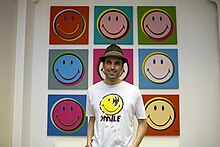
An emoticon, short for emotion icon, is a pictorial representation of a facial expression using characters—usually punctuation marks, numbers, and letters—to express a person's feelings, mood, or reaction, without needing to describe it in detail.

A smiley, sometimes called a smiley face, is a basic ideogram representing a smiling face. Since the 1950s, it has become part of popular culture worldwide, used either as a standalone ideogram or as a form of communication, such as emoticons. The smiley began as two dots and a line representing eyes and a mouth. More elaborate designs in the 1950s emerged, with noses, eyebrows, and outlines. New York radio station WMCA used a yellow and black design for its "Good Guys" campaign in the early 1960s. More yellow-and-black designs appeared in the 1960s and 1970s, including works by Harvey Ross Ball in 1963, and Franklin Loufrani in 1971. Today, The Smiley Company founded by Franklin Loufrani claims to hold the rights to the smiley face in over 100 countries. It has become one of the top 100 licensing companies globally.

Harvey Ross Ball was an American commercial artist. He is recognized as the inventor of the popular smiley face graphic picture, which became an enduring and notable international icon. He never applied for a trademark for the iconic smiley image and only earned $45 for his efforts. Ball later founded the World Smile Foundation in 1999, a non-profit charitable trust that supports children's causes.

An emoji is a pictogram, logogram, ideogram, or smiley embedded in text and used in electronic messages and web pages. The primary function of modern emoji is to fill in emotional cues otherwise missing from typed conversation as well as to replace words as part of a logographic system. Emoji exist in various genres, including facial expressions, expressions, activity, food and drinks, celebrations, flags, objects, symbols, places, types of weather, animals and nature.

PLBY Group, Inc. is an American global media and lifestyle company founded by Hugh Hefner as Playboy Enterprises, Inc. to oversee the Playboy magazine and related assets. Its headquarters are in Los Angeles, California.

Lacoste S.A. is a luxury sports fashion French company, founded in 1933 by tennis player René Lacoste, and entrepreneur André Gillier. It sells clothing, footwear, sportswear, eyewear, leather goods, perfume, towels and watches. The company can be recognised by its green Crocodile logo. René Lacoste, the company's founder, was first given the nickname "the Crocodile" by the American press after he bet his team captain a crocodile-skin suitcase that he would win his match. He was later redubbed "the Crocodile" by French fans because of his tenacity on the tennis court. In November 2012, Lacoste was bought outright by Swiss family-held group Maus Frères.

Eat'n Park is a restaurant chain based in Homestead, Pennsylvania. As of March 2024, the company operates 56 locations in Ohio, Pennsylvania, and West Virginia. The chain is known for its Smiley Cookies and has adopted the motto, "the place for smiles".

Moschino is an Italian luxury fashion house founded in 1983 by Franco Moschino in Milan known for over-the-top, campy designs. The company specializes in ready-to-wear, handbags, and fashion accessories. Moschino's creative director is Adrian Appiolaza.
Irony punctuation is any form of notation proposed or used to denote irony or sarcasm in text. Written text, in English and other languages, lacks a standard way to mark irony, and several forms of punctuation have been proposed to fill the gap. The oldest is the percontation point in the form of a reversed question mark, proposed by English printer Henry Denham in the 1580s for marking rhetorical questions, which can be a form of irony. Specific irony marks have also been proposed, such as in the form of an open upward arrow, used by Marcellin Jobard in the 19th century, and in a form resembling a reversed question mark, proposed by French poet Alcanter de Brahm during the 19th century.
Crocs, Inc. is an American footwear company based in Broomfield, Colorado, that manufactures and markets the Crocs brand of foam footwear. Crocs Inc term these "clogs", but they do not contain any wood like traditional clogs.

Pile of Poo (💩), also known informally as the poomoji (slang), poop emoji, or poo emoji, is an emoji resembling a coiled pile of feces, usually adorned with cartoon eyes and a large smile. Originated from Japan, it is used as an expression of various contexts. Some possible uses include: as a response of passive aggressive emotion, for comedic value, as commentary on what's bad, or as its literal meaning.
Apple Color Emoji is a color typeface used on Apple platforms such as iOS and macOS to display Emoji characters.
A sticker is a detailed illustration of a character that represents an emotion or action that is a mix of cartoons and Japanese smiley-like "emojis" sent through instant messaging platforms. They have more variety than emoticons and have a basis from internet "reaction face" culture due to their ability to portray body language with a facial reaction. Stickers are elaborate, character-driven emoticons and give people a lightweight means to communicate through kooky animations.

Kaomoji was invented in the 1980s as a way of portraying facial expressions using text characters in Japan. It was independent of the emoticon movement started by Scott Fahlman in the United States in the same decade. Kaomojis are most commonly used as emoticons or emojis in Japan.

Face with Tears of Joy (😂) is an emoji that represents a crying with laughter facial expression. While it is broadly referred to as an emoji, since it is used to demonstrate emotion, it is also referred to as an emoticon. Since the emoji has evolved from numerous different designs pre-unicode, it has different names and meanings in different regions and cultures. It is also known as Tears of Joy emoji, lol emoji, joy emoji, laughing emoji, cry-laugh emoji, crying laughing emoji, or the laughing crying emoji. The emoji is used in communication to portray joking and teasing on messaging platforms including Apple's iMessage and Meta's WhatsApp, as well as social media websites such as Facebook, Snapchat, Twitter, and Instagram. The emoji is one of the most commonly used emojis in the Emoticons Unicode block. The Oxford Dictionary recognized the emoji as its Word of the Year in 2015 due to its popular usage, and regarded it as the most popular emoji.
An emoji domain is a domain name with one or more emoji in it, for example 😉.tld.
O'Plérou Grebet is an Ivorian artist, graphic designer and illustrator known to have designed more than 365 free emojis that portrays West African culture. He was named in the Forbes Africa 30 Under 30 list.
Smiley News is a British news publication, which focuses on positive news aligned with the UN's Sustainable Development Goals. It was founded in 2017, nearly four decades after Franklin Loufrani included feel-good stories in the French newspaper France-Soir. It also runs a series of nationwide events called Smiley Talks, which feature people telling personal stories.

The Heart Eyes (😍) emoji is an ideogram that is used in communication to express happiness towards something. The Unicode Consortium listed it as the third most used emoji in 2019.













